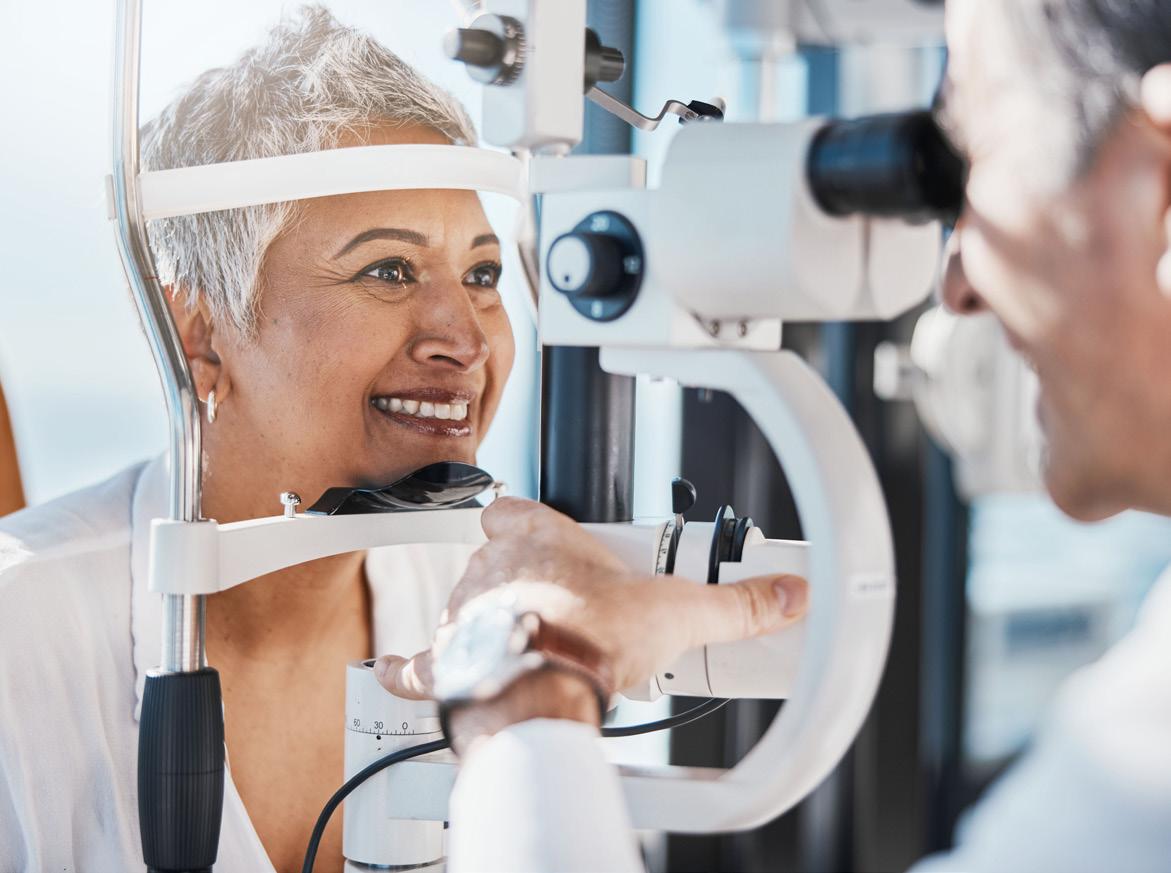
FS-2023-0667 | March 2024
Age-Related Eye Health Issues and How to Manage Them
Vision Over 60 Years of Age

Our vision changes as we age. Most of these changes are very gradual and, with medical advancement, can be treated or prevented. As per the National Eye Institute (2021), 24.4 million Americans (over 40 years of age) have cataracts, 77 million have diabetic retinopathy, 2.7 million have glaucoma, and 2.1 million have age-related macular degeneration (See pages 3 and 4 for these disease descriptions).
Many adults (over 40 years of age) may also experience difficulty seeing close distances, especially when reading or working on a computer (Ellis, 2022). These changes can affect the eyes’ ability to focus. It can be frustrating for individuals who never had to wear prescription eyeglasses or contact lenses. But it can also be as simple a solution as wearing them regularly. Adults are at a higher risk for developing vision problems if they experience the following health issues (American Optometric Association [AOA], n.d.; Cleveland Clinic, 2020):
- Chronic diseases such as diabetes and high blood pressure
- Family history of glaucoma or macular degeneration
- A highly demanding job that includes eye-hazardous elements (such as construction, healthcare, and automotive occupations)
- Higher cholesterol levels, thyroid issues, anxiety and depression, and arthritis
- Use of certain medications, such as antihistamines, that can have vision side effects
- Higher weight or obesity
Age-Related Vision Changes
With age, our vision goes through a variety of changes. However, only some individuals may experience theses changes. The following changes illustrate the common age-related changes:

- Need for More Light: You may realize the need to use brighter lights when reading a newspaper, book, and/or computer (AOA, n.d.).
- Presbyopia: The eyes become less flexible over time, leading to difficulty focusing on near objects or doing tasks that require closer focus, such as needleworking, painting, reading, and knitting (Cleveland Clinic, 2020).
- Glare Issue: You might notice that while driving at night, the glare from the car headlights, the sun reflecting off the windshield, or other reflective surfaces becomes more bothersome than before (Cleveland Clinic, 2020). Age-related changes in the retina can cause scattering of the light entering the eyes as compared to it being focused precisely on the retina. This scattered light on the retina causes more glare (Cleveland Clinic, 2022; National Institute on Aging [NIA], 2021).
- Color Perception: A clear lens inside our eyes can start discoloring, leading to distortion of color perception and making it difficult to distinguish specific colors, such as identifying pastel colors with white. (AOA, n.d.; Cleveland Clinic, 2022; National Eye Institute [NEIL 2021; NIA, 2021)
- Reduced Tear Production: Due to aging, changes in the tear glands can affect the number of tears produced. These changes can especially apply to women who experience hormonal changes such as menopause. Reduction in the production of tears can lead to dryness and irritation of the eyes. Tears are essential to keep the vision clear and eyes healthy. Your eye healthcare provider (an optometrist, a primary eye care doctor, or an ophthalmologist, a specialist eye care doctor) can often prescribe specific medication to help with tear production.
- Epiphora (excessive tears): This condition can cause a sensitivity to light, wind, or temperature changes. Protecting eyes with sunglasses can sometimes solve this problem. These issues can also be associated with more serious problems, such as an eye infection or a blocked tear duct (Ellis, 2020).
Common Eye Health Issues
If you experience any of the following severe eye health issues, please contact an ophthalmologist or optometrist for treatment (AOA, n.d.; Cleveland Clinic, 2020).
FLUCTUATING VISION:
If you notice a frequent fluctuation in your vision, you might have diabetes or high blood pressure (AOA, n.d.). These conditions damage the tiny blood vessels of the retina. It can lead to temporary as well as permanent damage to your eyes.
FLOATERS AND FLASHES:
You may see shadowy images of floating particles in the fluids inside the eyes. Usually, these floaters are not damaging to the eyes, but if you notice an increase in the number of floaters with bright flashing lights, make sure to see an ophthalmologist or optometrist.
CATARACTS:

Cataracts are cloudy areas that develop in the lens in front of the eyes. A healthy lens is clear, and it easily passes light to the back of the retina. Due to the cloudiness of the lens, light cannot easily penetrate it, causing blurred vision. This issue develops slowly without any symptoms such as pain or redness of the eyes. Cataracts can be easily treated with surgery that replaces a cloudy lens with a new plastic lens.
LOSS OF SIDE VISION:
Losing side or peripheral vision is one of the signs of glaucoma.
SEEING DISTORTED IMAGES:
This issue can cause straight lines to appear wavy or jagged with missing areas in the center of your vision. It can be caused by age-related macular degeneration. Regular eye examination and early diagnosis, as well as treatment, can help to preserve your vision.
AGE-RELATED MACULAR DEGENERATION (AMD):

AMD is a commonly occurring eye disease for individuals over 60 years of age. It adversely affects the eye’s macula. The macula part of the eye is responsible for sharp central vision, which helps to see details such as facial recognition and reading. AMD causes blurred vision and distorted central vision and is a leading cause of blindness among oIder adults. Laser treatment, good nutrition, and surgery can help treat and manage AMD (NIA, 2021). There are two types of AMD: dry and wet form. The dry form causes yellow deposits in the macula, and the wet form causes blood vessels to leak and produce excess watery fluid in the eyes (Cleveland Clinic, 2020).
INCREASED EYE PRESSURE OR GLAUCOMA:
Glaucoma is a group of diseases that are associated with increased pressure in the eyes. It causes fluid build-up in the eyes that can damage the optic nerve, leading to permanent vision damage. Risk factors for this disease are genetics, age, race, diabetes, high cholesterol, and blood pressure (AOA, n.d.). Your eye care professional can prescribe eye drops, oral medications, and surgery to manage and treat glaucoma in advanced cases.
DIABETIC RETINOPATHY:
This condition is one of the complications of chronic uncontrolled diabetes. Tiny blood vessels of the eyes cannot provide glucose (energy source) to the retina cells. The advanced stages of retinopathy can lead to leaky fluids from the blood vessels, blurred vision, floaters, blind spots, and cloudiness. It can also lead to vision loss and blindness (Cleveland Clinic, 2020; NIA, 2021)
Manage Your Eye Health
Protecting your eyes through a healthier lifestyle can positively impact your eye health and reduce the risk of age-related vision challenges.
Eat plenty of foods such as dark green leafy vegetables and foods high in omega-3 fats (Ellis, 2022; NEI, 2021; and NIA, 2021).

QUIT SMOKING
Smoking can increase the risk of macular degeneration and cataracts. It can also harm the optic nerve (NEl, 2021; NIA, 2021).

- Stay active: Staying active can help you manage high blood sugar, blood pressure, and cholesterol levels. It can prevent diabetic retinopathy and AMD (NEI, 2021; NIA, 2021).
- Wear protective sunglasses: Sunglasses can help to protect the eyes from UV rays and blue light from electronic screens. UV light exposure can lead to cataracts. Blue lights from the solar spectrum can increase the chances of AMD. Glasses coated with a special film can reduce discomfort from glare (NEI, 2021; NIA, 2021).
- Taking a break from the screen: Try to take short breaks while spending extensive time in front of the screen, such as on a computer, phone, tablet, or TV. Look at objects that are about 20 feet away for 20 seconds to readjust your focus (NEl, 2021).
- Follow safe steps while using the contacts: Make sure to wash your hands before inserting and removing contact lenses. Be sure to replace contact lens solutions often. Follow recommendations from the contact lens solution company packaging (NEI, 2021).
- Regular eye exams: Ensure your eyes are checked at least once a year. If you have diabetes or high blood pressure, consult your primary care provider and an eye care professional regularly regarding necessary eye tests (Cleveland Clinic, 2020; NEI, 2021)
Foods That Promotes Eye Health

Many nutrients we consume can promote eye health. Try including the following foods within your diet. Make sure to consume these in accordance with your clinical history, allergies, and food intolerances. Consult your healthcare professional before drastically changing your dietary intake based on the list below.
- Kale: Rich in vitamin A and beta-carotene, it can potentially protect eyes from sun damage and prolong age-related eye changes (AOA, n.d; NEl, 2021).
- Strawberries: High amounts of vitamin C in this fruit can help fight free radicals (cell-damaging molecules) and help reduce the risk of cataracts (Ellis, 2022).
- Sweet potatoes: These root vegetables contain higher amounts of beta-carotene (a type of vitamin A), which can help with dry eyes and night blindness (ElIis, 2022).
- Omega-3 Fats: Omega-3 is a type of fat found in mackerel, salmon, cod liver oil, sardines, flaxseed, chia seeds, and walnuts. Omega-3 is anti-inflammatory in nature, which can help protect the eyes against free radical damage. Studies have shown a positive effect of omega-3 in conditions such as dry eyes (AOA, n.d.; NEl, 2021).
Other foods that may be beneficial for your eye health benefits are (Ellis, 2022; NIA, 2021):
- Vegetables: Broccoli, yellow squash, carrots, butternut squash, bell peppers, dark green leafy vegetables
- Fruits: Kiwi, red grapes, oranges, and papaya
- Other foods: eggs and liver
Summary
Our vision changes with age. These changes are slow and often go unnoticed. Learning about these vision-related changes, signs of major eye health issues, and making healthful choices can help prevent and delay vision issues. Certain chronic diseases, family history, obesity, and certain medications can pose risk factors for vision-related problems.
With age, we start to experience glare issues, a reduction or increase in tear production, a need for brighter lights, presbyopia, and changes in color perception. One may also notice fluctuating vision, floaters/flashes, cataracts, loss of side vision, and distortion in vision. Work with general healthcare providers, including eye healthcare providers, about your risk of agerelated macular degeneration, glaucoma, and diabetic retinopathy.
However, lifestyle changes such as staying active, wearing sunglasses, taking breaks from the screen, not smoking, getting a regular eye exam, and eating more vision-friendly foods can help keep your vision healthy.
REFERENCES
- American Optometric Association (N.D.) Adult vision: 41 to 60 years of Age. https://www.aoa.org/healthy-eyes/eye-health-for-life/adult-vision-41-to-60-years-of-age?sso=y
- Cleveland Clinic. (2020). Common age-related eye problems. Retrieved from: https://my.clevelandclinic.org/health/articles/8567-common-age-related-eye-problems
- Ellis, E. (2022). Foods for eye health. Academy of Nutrition and Dietetics.https://www.eatright.org/health/wellness/healthful-habits/5-top-foods-for-eye-health
- National Eye Institute (2021). Keep your eyes healthy. https://www.nei.nih.gov/learn-about-eye-health/healthy-vision/keep-your-eyes-healthy
- National Institute on Aging (2021). Aging and your eyes. https://www.nia.nih.gov/health/vision-and-vision-loss/aging-and-your-eyes
DHRUTI PATEL
dhrutip@umd.edu
MONA HABIBI
mhabibi@umd.edu
CHERYL BUSH
cherb@umd.edu
This publication, Age-Related Eye Health Issues and How to Manage Them (FS-2023-0667), is a part of a collection produced by the University of Maryland Extension within the College of Agriculture and Natural Resources.
The information presented has met UME peer-review standards, including internal and external technical review. For help accessing this or any UME publication contact: itaccessibility@umd.edu
For more information on this and other topics, visit the University of Maryland Extension website at extension.umd.edu
University programs, activities, and facilities are available to all without regard to race, color, sex, gender identity or expression, sexual orientation, marital status, age, national origin, political affiliation, physical or mental disability, religion, protected veteran status, genetic information, personal appearance, or any other legally protected class.
When citing this publication, please use the suggested format below:
Patel, D., Habibi, M., & Bush, C. (2024). Age-Related Eye Health Issues and How to Manage Them (FS-2023-0667). University of Maryland Extension. go.umd.edu/FS-2023-0667